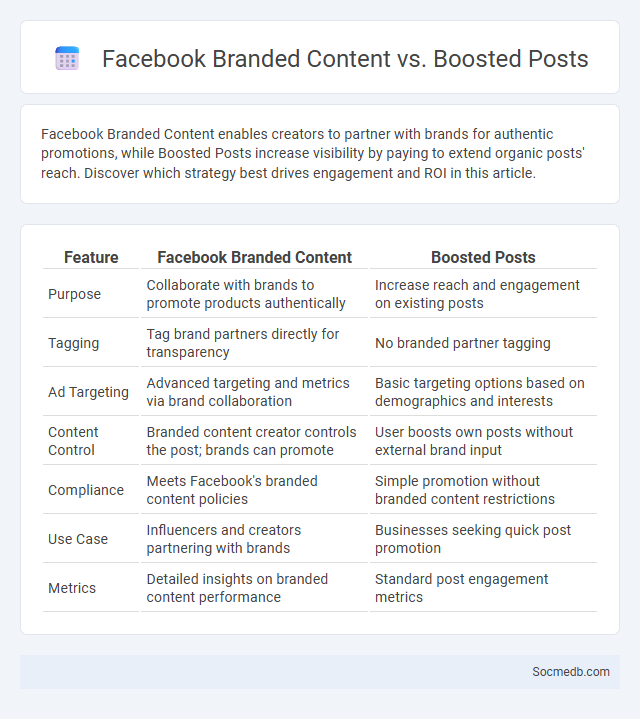
Photo illustration: Facebook Branded Content vs Boosted Posts
Facebook Branded Content enables creators to partner with brands for authentic promotions, while Boosted Posts increase visibility by paying to extend organic posts' reach. Discover which strategy best drives engagement and ROI in this article.
Table of Comparison
| Feature | Facebook Branded Content | Boosted Posts |
|---|---|---|
| Purpose | Collaborate with brands to promote products authentically | Increase reach and engagement on existing posts |
| Tagging | Tag brand partners directly for transparency | No branded partner tagging |
| Ad Targeting | Advanced targeting and metrics via brand collaboration | Basic targeting options based on demographics and interests |
| Content Control | Branded content creator controls the post; brands can promote | User boosts own posts without external brand input |
| Compliance | Meets Facebook's branded content policies | Simple promotion without branded content restrictions |
| Use Case | Influencers and creators partnering with brands | Businesses seeking quick post promotion |
| Metrics | Detailed insights on branded content performance | Standard post engagement metrics |
Understanding Facebook Branded Content
Facebook Branded Content enables creators and businesses to share sponsored posts while maintaining transparency through clear labeling. This tool enhances brand visibility by leveraging influencer reach and authentic engagement, driving higher conversion rates. Understanding Facebook Branded Content policies ensures compliance, fostering trust and maximizing advertising effectiveness on the platform.
What Are Boosted Posts on Facebook?
Boosted posts on Facebook are paid advertisements designed to increase the visibility of a specific post beyond its organic reach. By targeting a defined audience based on demographics, interests, and behaviors, boosted posts enhance engagement such as likes, comments, and shares. This feature allows businesses to promote content efficiently, driving traffic and improving brand awareness on the platform.
Key Features of Facebook Branded Content
Facebook Branded Content offers key features such as content tagging, which allows creators and brands to transparently disclose partnerships and share revenue insights. Branded Content ads enable targeted promotion, enhancing reach and engagement through Facebook's robust advertising tools. The platform supports performance metrics like audience insights and engagement analytics, empowering advertisers to optimize campaigns efficiently.
Boosted Posts: Core Benefits and Use Cases
Boosted posts on social media platforms like Facebook and Instagram increase content visibility by targeting specific audience segments, enhancing engagement rates and driving website traffic. They provide measurable metrics such as reach, clicks, and conversions, allowing businesses to optimize marketing strategies effectively. Ideal use cases include promoting events, product launches, and time-sensitive offers to maximize real-time audience interaction and brand awareness.
Comparing Facebook Branded Content vs. Boosted Posts
Facebook Branded Content involves partnerships where creators produce authentic promotional posts that seamlessly integrate the brand, enhancing trust and engagement through storytelling. Boosted Posts simply increase the reach of existing content by paying for broader distribution, often targeting audiences based on demographics and interests without altering the original message. Brands leveraging Branded Content typically achieve higher engagement rates and deeper audience connections compared to the broader but less personalized exposure from Boosted Posts.
Targeting and Reach: Which Delivers More Value?
Targeting in social media marketing delivers more value by allowing brands to connect with specific audience segments based on demographics, interests, and behaviors, resulting in higher engagement and conversion rates. Reach focuses on the total number of users exposed to content, which can increase brand awareness but often leads to lower relevancy and engagement. Precision targeting ensures marketing budgets are optimized by minimizing wasted impressions and maximizing the impact on potential customers.
Engagement Metrics: Branded Content vs. Boosted Posts
Engagement metrics reveal significant differences between branded content and boosted posts on social media platforms, with branded content often generating higher authenticity and longer-lasting interactions due to organic reach and influencer partnerships. Boosted posts typically deliver quick visibility spikes and increased impressions, but may result in lower engagement quality since they target broader audiences through paid amplification. Understanding these nuances helps you optimize your social media strategy by balancing genuine user engagement with strategic promotion to maximize ROI.
Compliance and Disclosure Requirements
Compliance with social media regulations mandates transparent disclosure of sponsored content to avoid legal penalties and maintain brand integrity. Businesses must follow guidelines set by bodies such as the Federal Trade Commission (FTC) in the United States, ensuring all endorsements, advertisements, and partnerships are clearly labeled. Proper adherence to disclosure requirements enhances consumer trust and reduces the risk of regulatory enforcement or reputational damage.
Cost Efficiency and Budget Optimization
Social media advertising delivers high cost efficiency by targeting specific demographics, reducing wasted ad spend and maximizing return on investment (ROI). Platforms like Facebook and Instagram provide detailed analytics and budget controls, allowing marketers to optimize campaigns in real-time for better performance. Leveraging these tools helps businesses achieve effective budget allocation and increased engagement without exceeding financial constraints.
Choosing the Right Strategy for Your Brand
Selecting the right social media strategy for your brand involves analyzing target audience demographics, platform-specific behavior, and content preferences to maximize engagement and conversion rates. Leveraging data analytics tools such as Facebook Insights, Instagram Analytics, and Twitter Analytics provides actionable insights to tailor content types and posting schedules effectively. Aligning social media goals with broader marketing objectives ensures consistent brand messaging and measurable ROI across campaigns.
 socmedb.com
socmedb.com